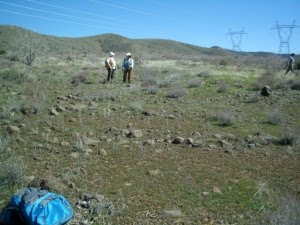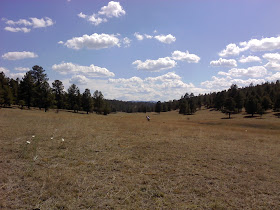Archaeology Week: Part 2
Jan 26, 2010
Leave a Comment
This is a continuation of my previous post about archaeology in the southwest and what kinds of things I found and learned about in the Arizona desert.
Agriculture
Agricultural tradition in the Southwestern U.S. originally came from Mexico. In 3000 BC, people were growing corn, beans and squash, and other plants were added over the years. Irrigation was used to adapt the southwest to farming conditions of the wetter Mexican crops.
Archaeologists recognize prehistoric agricultural sites in the field by the presence of agricultural terraces, like those in the picture shown below. We found quite a few of these as well, and this one was the most obvious.
prehistoric agricultural terraces, humans for scale
They will often be found in a cleared area with little to no artifacts and tend to have less vegetation than the surrounding areas, due to extended use of the soil and depletion of nutrients.
FUN FACT! Growing too much corn in one spot over a long period of time takes all the iron out of the soil and causes anemia in people who eat it. Image from here.
One of the later plants used by the prehistoric people was the agave, which grew as both a native and a cultivated plant. Agave prefer to grow in rocky, well drained soil, like in the picture shown here.
Prehistoric people planted agave in rock piles, which can still be seen today, without the agave.
Image from here
Some species of agave, like Murphy’s Agave, were developed specifically for cultivation. Murphy’s Agave doesn’t flower like most other agave species do, but instead sprouts little agaves that can be picked off and planted somewhere else. (I couldn’t find a picture of this. boo!  … Our teacher just told us about it. I really would like to see what it looks like.)
… Our teacher just told us about it. I really would like to see what it looks like.)
So what did they use the agave for? Well, they used it for a couple things. What they did was take something (like a stick) and use it as a lever-type device to pry the agave plant out at its root. The bottom of an agave is sort of like an artichoke, and the prehistoric people would cook it in a roasting pit. Evidence of a prehistoric roasting pit is something called slag. In geology, slag means the stuff that comes out of an iron furnace. In archaeology, as I found out, it also means burnt soil from a roasting pit. It looks like this:
Which reminds me, there’s other burnt old stuff, that provides evidence for an archaeological site. This is burnt daub.
It’s adobe from a stone structure that burned down and collapsed. Cool, huh?
Anyway, back to the agave. The leaves were also useful. Their insides are made of fibers that could be used for making cloth and baskets and other stuff you use fibers for.
And that is about it for agriculture. I will add the final installment tomorrow.









Ok, love these posts! I can't believe I've never been to Arizona...I think it's time for me to plan a trip.
And I'm totally frickin annoyed that I've been following the wrong blog of yours which means I haven't seen any of these posts! You've been added to the google reader, so we're all good now :)